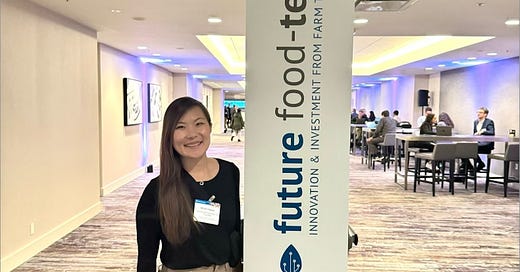Notable Industry Trends in Alternative Proteins
Insights and Reflections from the Future Food Tech Conference
This is Minami - PhD fellow at Supply Change Capital, giving you the latest on novel foods and alternative proteins.
While it’s more common now to see an Impossible Burger option on the menu or a restaurant or fast-food chain dedicated to a 100% vegan menu, alternative proteins are not yet mainstream.
Recently, I attended Future Food Tech Alt Proteins, a conference dedicated to discussing these challenges by the biggest stakeholders and most active players in the alternative protein industry. Our very own Shayna Harris participated in a panel discussion on “Boosting Investor Confidence: Adapting Innovative Financing Models to Overcome the Trough of Disillusionment.”
Recurring topics onstage included discussions of early corporate engagement, the rise in hybrid products, and new studies on consumer acceptance of novel proteins. Here are the top trends in the alternative protein field that everyone is talking about:
Enter corporates. At this year’s conference in Chicago, it was notable to see major food industry players like Ajinomoto, ADM, Mars, Unilever, Cargill, Danone, and many more in attendance. Their involvement highlights the importance of established companies in driving food innovation. We’re seeing more of these collaborations, partnerships, and M&As happen earlier in the timeline than we’ve seen historically, perhaps because corporations realize the value of early innovation in the alternative protein sector. For startups, partnerships with established corporations can rapidly advance production scale-up and obtain essential resources and infrastructure. These collaborations offer benefits like cost savings on utilities and permitting enhancing capital efficiency. Some notable collaborations in the past year include:
ADM partnered with Believer Meats to enhance and refine the cultivated meat production process
MorningStar Farms and Pringles developed a new line of plant-based chicken fingers
Above Food, known for its plant-based ingredients and products, merged with Bite Acquisition Corp., a publicly traded SPAC, with a deal valued at $319 million
Cargill partnered with ENOUGH to produce mycoprotein
Shift to hybrid. Hybrid products are on the minds of many who are searching for an immediate solution to get more alternative proteins to market. They combine different sources of high-protein ingredients as a single product that is not siloed into one of the three alternative categories (plant-based, fermented, cultivated). These products often blend plant-based proteins with traditional animal meat, and efforts are underway to integrate cultivated fats (adipocytes) with plant-based proteins. At the conference, we tasted hamburgers from 50/50 Foods Inc, half all-natural veggies, and half grass-fed beef. Some other examples of hybrids include plant-based eggs or milk enriched with cultivated and/or plant-based ingredients. Here are the reasons why hybrids are attractive:
Hybrid products present a promising path to reducing costs and accelerating production scalability. Manufacturers can achieve price parity by mixing lower-cost plant-based inputs with higher-cost materials (such as cultivated meat and fat).
Combining vegetables with meat is not new; it is a common, if not obvious, practice in many traditional foods. A meatloaf isn't complete without the savory diced onions and one, two, or heck, half a head of garlic, right? Hybrid products leverage this familiarity, offering a smoother transition for consumers from animal-based meat to alternative protein sources.
One key advantage of hybrid products is the potential to leverage the diverse material properties of multiple inputs to enhance the final product's taste and texture. For example, plants naturally contain more fiber, enriching the texture properties that double as a prebiotic.
Hybrid products can also offer significant nutritional benefits. A study by Baune et al. 2023 showed that hybrid meatballs had a reduced overall fat and, thus, calorie content and an increase in fiber compared to traditional animal-derived meatball control. This combination can lead to products that are not only delicious but also packed with essential nutrients, promoting better health for consumers.
Consumers and their opinions matter. Consumers are open to trying alternative proteins for the first time. Many are eager to give these products a chance, but the challenge lies in retaining them. While two-thirds of consumers express willingness to replace meat with alternative proteins, only about a quarter consistently follow through with this change (McKinsey and Co). Another interesting data point shared in the report was that consumers are more willing to incorporate alternative proteins into their breakfast rather than lunch or dinner. Food is highly tied to culture, emotion, and gathering. Meals that are typically larger and linked to tradition are less amenable to new and unfamiliar food forms. Here are the key points that were discussed in consumer adoption of alternative protein
Taste remains a crucial factor. No matter how sustainable or innovative an alternative protein product is, consumers won't buy it if it doesn’t taste good. Many alternative proteins still struggle to deliver a favorable taste experience, which hampers their acceptance and repeat purchases.
Sustainability is a value proposition for alternative proteins closely tied to their production methods. Additionally, alt protein startups distinguish themselves from competitors with their unique high-tech bioprocesses, using terms such as synbio, precision fermentation, and biotechnology. However, this can be off-putting to consumers, creating a disconnect with food. While deep tech is the moat, consumers prefer not to know the intricate science-heavy details of how their food is made.
Overall, it's evident that the alternative protein industry is still developing, and significant groundwork is needed to reach “a future where alternative proteins are no longer alternatives” (GFI). It might take time, but the answers are emerging. As I sat in the conference crowd, it was clear that we were all collectively there for the same reason: in one way or another, we believe this effort is pivotal in creating a sustainable, diverse, and nutritionally robust future food system.






